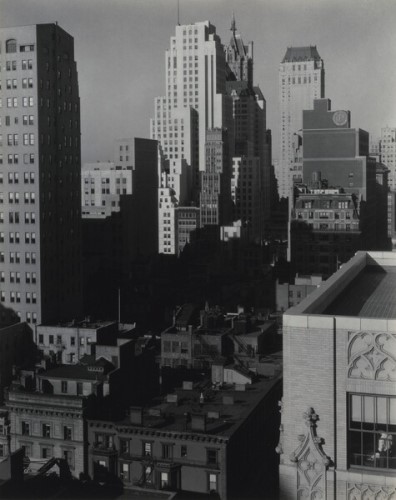Gelatin Silver Prints
Sarah S. Wagner

Alfred Stieglitz, New York from An American Place, 1931, gelatin silver print, National Gallery of Art, Washington, Alfred Stieglitz Collection, 1949.3.1243
Key Set number 1446
View all gelatin silver prints in the Key Set
Most twentieth-century black-and-white photographs are gelatin silver prints, in which the image consists of silver metal particles suspended in a gelatin layer. Gelatin silver papers are commercially manufactured by applying an emulsion of light-sensitive silver salts in gelatin to a sheet of paper coated with a layer of baryta, a white pigment mixed with gelatin. The sensitized paper is exposed to light through a negative and then developed out—that is, made visible in a chemical reducing solution. William Henry Fox Talbot introduced the basic chemical process in 1839, but the more complex gelatin silver process did not become the most common method of printing black-and-white photographs until the late 1910s. Because the silver image is suspended in a gelatin emulsion that rests on a pigment-coated paper, gelatin silver prints can be sharply defined and highly detailed in comparison to platinum or palladium prints, in which the image is absorbed directly into the fibers of the paper.
From the 1880s through the turn of the twentieth century, Alfred Stieglitz published articles about his experiments with early silver papers in which the image was printed out, or made visible through exposure to light, but no examples exist in the Key Set. From the early 1920s through 1937, he printed on a variety of commercial developing-out gelatin silver papers. The surfaces of his prints range from matte to glossy.
During World War I, when his preferred platinum papers became difficult to obtain, Stieglitz, along with other photographers, experimented with a variety of silver gelatin papers that mimicked platinum prints (also known as platinotypes). These new faux platinum alternative photographic papers, which were introduced as early as the 1890s, often featured “platino” in their names, such as Platino Matte Surface and Platino Bromide. These papers, offered in a variety of velvety surfaces, provided prints that were advertised as difficult to distinguish from ones made using platinum papers. The matte surface of these silver papers could be imparted by avoiding very smooth paper supports and adding matting agents to the binder such as starch and silica. Various metal salts could be adjusted to create the black and sepia hues typical of platinum prints.
Stieglitz grew to appreciate the surface of the Japine Platinotype that he used during the 1910s. He experimented with gelatin silver papers with semigloss surfaces similar to Japine, along with the occasional matte-surfaced gelatin paper, perhaps to see if the appearance of a new product could match his favorite platinum papers. Stieglitz took the additional step of waxing his silver prints to impart a subtle sheen and a surface appearance similar to Japine.
Suggested Reading
McCabe, Constance. “Coatings on Photographs by Alfred Stieglitz.” In Coatings on Photographs: Materials, Techniques, and Conservation, edited by Constance McCabe, 300–313. Washington, DC: American Institute for Conservation of Historic and Artistic Works, 2005.
Wagner, Sarah S. “Manufactured Platinum and Faux Platinum Papers, 1880s–1920s.” In Platinum and Palladium Photographs: Technical History, Connoisseurship, and Preservation, edited by Constance McCabe, 144–183. Washington, DC: American Institute for Conservation of Historic and Artistic Works, 2017.